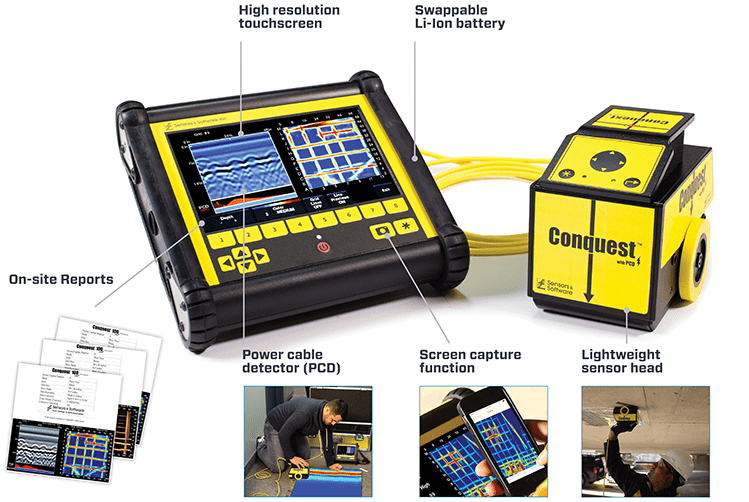Efficient Concrete Scanning Methods for Construction Projects
Efficient Concrete Scanning Methods for Construction Projects
Blog Article
Unveil the Transformative Power of Concrete Scanning in Making The Most Of Performance and Safety
Concrete scanning has emerged as an important tool in the construction market, supplying unrivaled benefits in improving job effectiveness and making sure security standards. The transformative power of concrete scanning lies in its capability to provide real-time information and comprehensive understandings, changing exactly how jobs are planned and performed.
Relevance of Concrete Scanning
Ensuring the structural honesty and security of building and construction tasks starts with the vital step of carrying out comprehensive concrete scanning. Concrete scanning is a non-destructive approach made use of to spot and map subsurface aspects within concrete frameworks. This process is necessary in identifying potential dangers, such as rebar, post-tension cable televisions, and channels, that may be concealed within the concrete. By using innovative modern technologies like ground-penetrating radar (GPR) and electromagnetic induction, building groups can properly situate these components without triggering any damage to the structure.
The importance of concrete scanning can not be overemphasized, as it plays an important role in stopping mishaps, minimizing task delays, and making sure the long-term toughness of the building. By recognizing possible threats before the construction phase begins, home builders can apply appropriate precaution and make educated choices concerning the layout and implementation of the job. Additionally, concrete scanning helps in optimizing project timelines and budget by staying clear of unanticipated costs and delays that may emerge because of unpredicted obstructions within the concrete. Inevitably, purchasing thorough concrete scanning is a positive approach that improves both effectiveness and security in building projects.
How Concrete Scanning Functions
Concrete scanning runs as a vital tool in construction jobs by utilizing innovative innovations to identify and map subsurface aspects without causing structural damage. Ground Permeating Radar (GPR) and Electromagnetic Induction (EMI) are 2 primary techniques used in concrete scanning. GPR works by releasing high-frequency radar pulses into the surface, which recuperate when they experience subsurface things or gaps. The time taken for the signal to return suggests the depth and place of the objects. EMI, on the various other hand, makes use of electromagnetic areas to recognize variances in material make-ups, such as recognizing rebar or avenues within concrete frameworks.
Throughout the scanning procedure, the information collected is evaluated in real-time, enabling instant recognition of potential hazards or challenges underneath the surface area. By utilizing these sophisticated innovations, concrete scanning significantly reduces the danger of pricey damages and injuries on building and construction websites.
Benefits of Concrete Scanning
One of the primary benefits of concrete scanning is the capability to identify and find ingrained objects such as rebar, post-tension cables, and avenues precisely. Concrete scanning assists in preparation and designing much more successfully, as it offers exact information regarding the area and depth of structural elements.
Study: Concrete Scanning Success

In an additional instance, a construction firm made use of 3D concrete scanning to assess the problem of maturing concrete structures in a historical building. The detailed scans offered valuable insights into the level of why not try these out degeneration and helped prioritize upkeep initiatives efficiently. By proactively addressing areas of concern identified with scanning, the company had the ability to expand the life expectancy of the structure and guarantee occupant safety.
These instance researches underscore the transformative power of concrete scanning in enhancing effectiveness, precision, and security in building and construction projects.
Carrying Out Concrete Scanning in Projects
Implementing sophisticated scanning technologies during building and construction projects has actually become significantly essential for enhancing precision and security. By integrating concrete scanning right into task planning and execution, construction groups can recognize possible dangers, such as rebar or post-tension cables, hidden within concrete frameworks. This aggressive approach decreases the risk of mishaps, hold-ups, and pricey rework, ultimately resulting in more efficient task timelines and budgets.
To execute concrete scanning effectively, project supervisors must collaborate very closely with knowledgeable scanning experts to figure out one of the most appropriate scanning strategies for the details task demands. Engaging scanning professionals from the very early phases of a job enables the group to produce extensive scanning plans that deal with crucial areas of worry and make certain comprehensive data collection.
In addition, incorporating concrete scanning right into normal project process can enhance decision-making procedures, as real-time scan information offers immediate insights right into the condition of concrete structures - Concrete Scanning. This data-driven method facilitates informed analytic and allows teams to make modifications without delay, promoting a society of performance and security throughout the job lifecycle

Verdict
To conclude, concrete scanning plays an essential duty in enhancing effectiveness and safety and security in building jobs. By making use of advanced innovation to map and identify out underlying structures within concrete, this process helps to stop costly blunders, guarantee structural stability, and minimize threats on site. With the capacity to discover concealed elements and supply precise information, concrete scanning proves to be a useful tool for maximizing task outcomes and taking full advantage of total success.
Concrete scanning is a non-destructive approach used to identify and map subsurface elements within concrete structures. Additionally, concrete scanning aids in optimizing project timelines and spending plan by preventing unanticipated costs and hold-ups that may emerge due to unanticipated obstructions within the concrete. One remarkable instance research study involves a large restoration task article where concrete scanning played a critical function in ensuring job success.In one more situation, a building and construction firm used 3D concrete scanning to evaluate the problem of maturing concrete structures in a historic structure. By integrating concrete scanning right into task planning and implementation, construction groups can determine prospective threats, such as rebar or post-tension cables, hidden within concrete structures.
Report this page